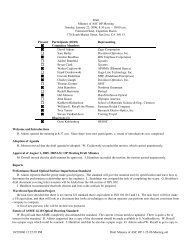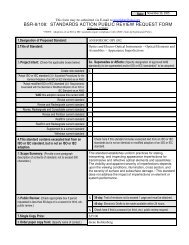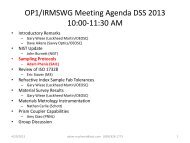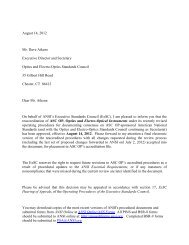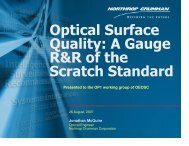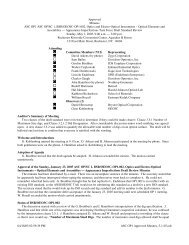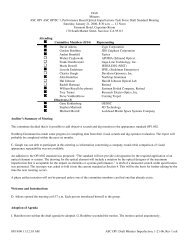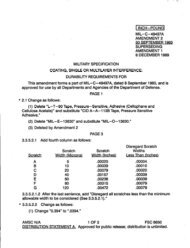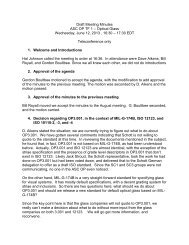INCH-POUND MIL-PRF-13830B 9 January 1997 SUPERSEDING ...
INCH-POUND MIL-PRF-13830B 9 January 1997 SUPERSEDING ...
INCH-POUND MIL-PRF-13830B 9 January 1997 SUPERSEDING ...
You also want an ePaper? Increase the reach of your titles
YUMPU automatically turns print PDFs into web optimized ePapers that Google loves.
<strong>MIL</strong>-<strong>PRF</strong>-<strong>13830B</strong><br />
conform to the requirements of C.3.5.<br />
APPENDIX C<br />
C.4.5.4.2 Lenses or components with curved surfaces. A coated lens or<br />
component with curved surface(s) shall be tested for increase in transmission by use<br />
of a photometer system (Pritchard Model No. 1980 or equivalent) that is capable of<br />
making a measured comparison between a coated and uncoated component. The<br />
increase in transmission after coating shall conform to the requirements of C.3.5.<br />
NOTE: The spectophotometric inspection methods specified in C.4.5.4.2 will only be<br />
used for acceptance inspection when it is necessary to evaluate a coated lens or<br />
component with curved surface(s) that has a visual discoloration since the values<br />
obtained are relative, not absolute.<br />
C.4.5.5 Film thickness. Perform this test on a witness piece, coated on one side,<br />
utilizing a spectrophotometer. A specular reflectance curve shall be obtained and<br />
used to determine the QWOT. The QWOT is the wavelength associated with the<br />
minimum point on the reflectance curve. The QWOT shall conform to the<br />
requirements of C.3.6 (See C.6.3).<br />
C.4.5.6 Reflectance at the minimum (witness pieces and plano surfaces). Perform<br />
this test concurrent with the test for optical film thickness. The percentage of<br />
reflectance at the minimum point on the spectral reflectance curve shall conform to<br />
the requirements of C.3.7.<br />
NOTE: This test is not applicable to components with curved surfaces.<br />
C.4.5.7 Salt solubility. The coated witness piece shall be immersed for a period of<br />
24 hours in a solution of water and sodium chloride (salt). The mixture shall be 6<br />
ounces (170 grams) of salt per gallon (3.8 liters) of water at room temperature (16° to<br />
32°C). Subsequent to this immersion the coated witness piece shall be removed from<br />
the solution and gently washed, or dipped in clean running water not warmer than<br />
100°F (38°C) to remove salt deposits. The witness piece shall then be cleaned (See<br />
C.4.5.1), dried, and then subjected to the examination specified in C.4.5.3.1<br />
Subsequent to the visual examination for physical defects the witness piece shall be<br />
subjected to the test in C.4.5.10. The film coating on the witness piece shall meet the<br />
requirements of C.3.8.1 and C.3.8.4.1.<br />
C.4.5.8 Humidity. The coated witness piece shall be placed into an<br />
environmentally controlled test chamber and exposed to a temperature of 120° ± 4°F<br />
(48° ± 3°C) 95% to 100% relative humidity for a minimum of 24 hours. Subsequent to<br />
this exposure the coated witness piece shall be removed from the test chamber,<br />
49<br />
Source: http://www.assistdocs.com -- Downloaded: 2006-05-24T15:32Z<br />
Check the source to verify that this is the current version before use.



